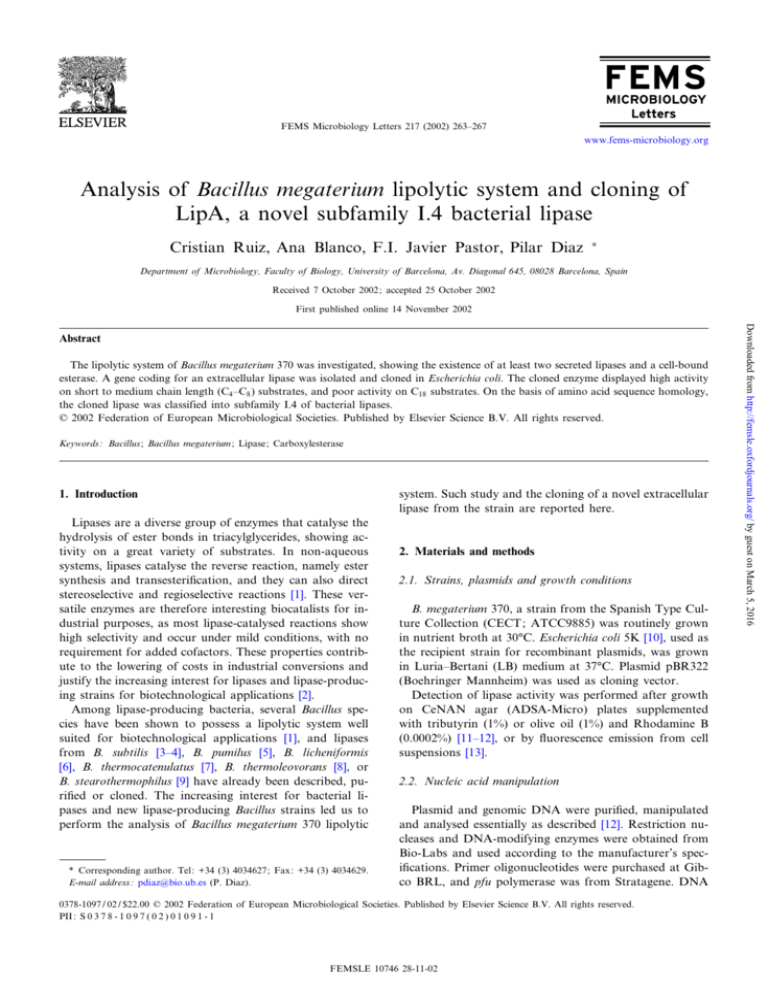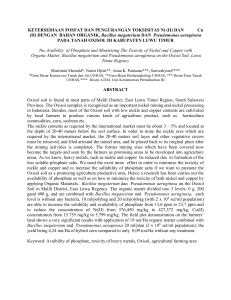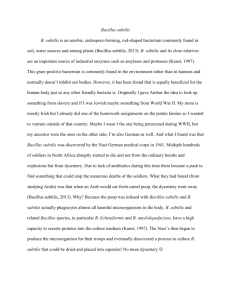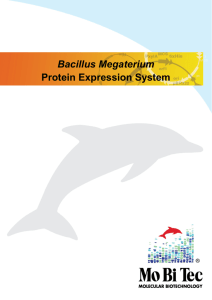
FEMS Microbiology Letters 217 (2002) 263^267
www.fems-microbiology.org
Analysis of Bacillus megaterium lipolytic system and cloning of
LipA, a novel subfamily I.4 bacterial lipase
Cristian Ruiz, Ana Blanco, F.I. Javier Pastor, Pilar Diaz
Department of Microbiology, Faculty of Biology, University of Barcelona, Av. Diagonal 645, 08028 Barcelona, Spain
Received 7 October 2002; accepted 25 October 2002
First published online 14 November 2002
The lipolytic system of Bacillus megaterium 370 was investigated, showing the existence of at least two secreted lipases and a cell-bound
esterase. A gene coding for an extracellular lipase was isolated and cloned in Escherichia coli. The cloned enzyme displayed high activity
on short to medium chain length (C4 ^C8 ) substrates, and poor activity on C18 substrates. On the basis of amino acid sequence homology,
the cloned lipase was classified into subfamily I.4 of bacterial lipases.
5 2002 Federation of European Microbiological Societies. Published by Elsevier Science B.V. All rights reserved.
Keywords : Bacillus; Bacillus megaterium ; Lipase; Carboxylesterase
system. Such study and the cloning of a novel extracellular
lipase from the strain are reported here.
1. Introduction
Lipases are a diverse group of enzymes that catalyse the
hydrolysis of ester bonds in triacylglycerides, showing activity on a great variety of substrates. In non-aqueous
systems, lipases catalyse the reverse reaction, namely ester
synthesis and transesteri¢cation, and they can also direct
stereoselective and regioselective reactions [1]. These versatile enzymes are therefore interesting biocatalists for industrial purposes, as most lipase-catalysed reactions show
high selectivity and occur under mild conditions, with no
requirement for added cofactors. These properties contribute to the lowering of costs in industrial conversions and
justify the increasing interest for lipases and lipase-producing strains for biotechnological applications [2].
Among lipase-producing bacteria, several Bacillus species have been shown to possess a lipolytic system well
suited for biotechnological applications [1], and lipases
from B. subtilis [3^4], B. pumilus [5], B. licheniformis
[6], B. thermocatenulatus [7], B. thermoleovorans [8], or
B. stearothermophilus [9] have already been described, puri¢ed or cloned. The increasing interest for bacterial lipases and new lipase-producing Bacillus strains led us to
perform the analysis of Bacillus megaterium 370 lipolytic
* Corresponding author. Tel: +34 (3) 4034627; Fax: +34 (3) 4034629.
E-mail address : pdiaz@bio.ub.es (P. Diaz).
2. Materials and methods
2.1. Strains, plasmids and growth conditions
B. megaterium 370, a strain from the Spanish Type Culture Collection (CECT; ATCC9885) was routinely grown
in nutrient broth at 30‡C. Escherichia coli 5K [10], used as
the recipient strain for recombinant plasmids, was grown
in Luria^Bertani (LB) medium at 37‡C. Plasmid pBR322
(Boehringer Mannheim) was used as cloning vector.
Detection of lipase activity was performed after growth
on CeNAN agar (ADSA-Micro) plates supplemented
with tributyrin (1%) or olive oil (1%) and Rhodamine B
(0.0002%) [11^12], or by £uorescence emission from cell
suspensions [13].
2.2. Nucleic acid manipulation
Plasmid and genomic DNA were puri¢ed, manipulated
and analysed essentially as described [12]. Restriction nucleases and DNA-modifying enzymes were obtained from
Bio-Labs and used according to the manufacturer’s speci¢cations. Primer oligonucleotides were purchased at Gibco BRL, and pfu polymerase was from Stratagene. DNA
0378-1097 / 02 / $22.00 5 2002 Federation of European Microbiological Societies. Published by Elsevier Science B.V. All rights reserved.
PII : S 0 3 7 8 - 1 0 9 7 ( 0 2 ) 0 1 0 9 1 - 1
FEMSLE 10746 28-11-02
Downloaded from http://femsle.oxfordjournals.org/ by guest on March 5, 2016
Abstract
264
C. Ruiz et al. / FEMS Microbiology Letters 217 (2002) 263^267
ampli¢cation was usually performed using 29 cycling periods of 30Q at 94‡C, 40Q at 42^55‡C, and 4P at 72‡C. DNA
was sequenced as described [12], homology analysed
through BLAST [14], sequence alignments were done using ClustalW (1.74) Multalign programme (http://www2.
ebi.ac.uk/clustalw), and signal peptide identi¢cation was
performed through SignalP V2.0 software [15]. The physico-chemical parameters of the deduced amino acid sequence and presence of de¢ned protein patterns were determined using the Prosite and ProDom databases at
ExPASY (http://www.expasy.org).
for con¢rmation, ligated to EcoRV-digested pBR322, and
cloned in E. coli 5K as described [18] for further characterisation.
2.5. Nucleotide sequence accession number
The DNA sequence of B. megaterium 370 (lipA_
BACME) lipase coding gene was submitted to the
EMBL under accession number AJ430831.
3. Results and discussion
2.3. Analysis of lipase activity
3.1. Analysis of B. megaterium 370 lipolytic system
2.4. Cloning procedure
Known lipase nucleotide sequences from B. subtilis
(M74010 and D78508), B. pumilus (A34992), B. licheniformis (AJ297356), Bacillus sp. (AF232707), B. thermocatenulatus (X95309), and B. stearothermophilus (U78785) were
aligned and the regions sharing the highest homology were
used to design a set of primers [FWSUB (5P-GAT ATT
GTG GCT CAT AGT ATG GGC GG) and BKSUB
(5P-GGC CTC CGC CGT TCA GCC CTT C)] for ampli¢cation of an internal lipase-coding DNA fragment from
B. megaterium 370. Sequencing of the synthesised DNA
fragment allowed the design of a new set of speci¢c divergent primers [BKMEGA (5P-CCC TCC TAA CGT CAC
GAC ATT TTC) and FWMEGA (5P-GCT TTC AAA
TAG TCA GGT TAA CGC G)], used to perform inverse
PCR for the sequencing of the presumed B. megaterium
370 lipase-coding gene [16].
The newly ampli¢ed DNA fragment showed high sequence identity with B. subtilis y¢P gene [17], although
several nucleotides were missing at its 3P-end. From the
results obtained, a new set of convergent primers corresponding to the 3P- and 5P-ends of the y¢P gene sequence
[FWY¢P (5P-GTC TAG AGG GGA ATA AAC GTG
AAA AAA G) and BKY¢P (5P-GGC ATG CAA GAT
ATT AAT TTG TAT TGA GG)], was used to perform
the ¢nal isolation of the complete ORF of B. megaterium
370 lipase-coding gene.
The blunt-ended DNA fragment obtained after ampli¢cation using primers FWY¢P and BKY¢P was sequenced
Presence of lipolytic activity in B. megaterium 370 was
analysed using Rhodamine B-supplemented plates [11],
containing tributyrin or olive oil. The strain showed
good performance on lipid-based substrate hydrolysis, as
con¢rmed by £uorescence emission from Rhodamine B
and appearance of hydrolysis areas around the colonies
(not shown).
Activity of concentrated supernatants and cell extracts
from B. megaterium was analysed on zymograms after
SDS^PAGE and IEF separation, using MUF-butyrate as
a substrate. A prominent band of ca. 65 kDa and a fainter
band of ca. 19 kDa appeared after zymographic analysis
of concentrated supernatants from B. megaterium 370
(Fig. 1). Study of the supernatants separated on isoelectrofocusing gels con¢rmed the presence of two activity
bands with a pI of 5.7 and 9.4, respectively (Fig. 1), indicating that the strain produces more than one extracellular enzyme with activity on MUF-butyrate, being the
band of 65 kDa the most abundant at the culture medium.
Zymographic analysis of crude cell extracts from
B. megaterium 370 separated on SDS^PAGE gels showed
the presence of a ca. 58-kDa band with activity on MUFbutyrate (Fig. 1). This band or its processed form was not
found at the supernatant, suggesting that the strain would
code for an additional non-secreted lipolytic enzyme. IEF
zymographic analysis of B. megaterium 370 cell extracts
con¢rmed the presence of a single prominent activity
band migrating at the acidic area (pI 5.5) of the gels
(Fig. 1). The pI and molecular weight similarity of
B. megaterium intracellular activity band with those of
previously described bacterial carboxylesterases, suggests
that this strain could bear a cell-bound esterase similar
to PnbA from B. subtilis [19], EstA1 from Bacillus sp.
BP-7 [20], or EstA from Paenibacillus sp. BP-23 [12].
3.2. Cloning of a B. megaterium lipase-coding gene
The nucleotide sequences of known Bacillus lipases were
aligned and the stretches of sequence identity used for the
isolation of a B. megaterium 370 lipase-coding gene by
means of direct and inverse PCR, as described in Section
FEMSLE 10746 28-11-02
Downloaded from http://femsle.oxfordjournals.org/ by guest on March 5, 2016
Activity and zymogram assays were routinely performed
using crude cell extracts or concentrated culture supernatants, prepared as previously described [12]. Lipolytic activity of the samples was determined by measuring the
release of para-nitrophenyl (pNP) or 4-methylumbelliferone (MUF) from pNP or MUF-derivative substrates, as
reported before [12]. One activity unit was de¢ned as the
amount of enzyme capable to release 1 Wmol of pNP or
MUF per minute under the reaction conditions used. Zymographic analysis of SDS^PAGE and IEF gels was performed as previously described [13].
C. Ruiz et al. / FEMS Microbiology Letters 217 (2002) 263^267
A
B
pI
kDa
- 5.5
- 5.7
- 65
- 58
Start
- 22
- 19
1
2
- 9.4
- 9.5
1
2
Fig. 1. Zymographic analysis on MUF-butyrate of B. megaterium 370
concentrated supernatants (1), and cell extracts (2), analysed by SDS^
PAGE (A) and IEF (B) gels. The molecular mass and pI of the bands
are indicated.
3.3. Analysis of the lipase coding sequence
lus lipases, was found with the ¢rst glycine typical residue
being replaced by an alanine [1]. Additionally, the cloned
lipase contains a His residue at position X1 like other
Bacillus lipases, while position X2 is occupied by a Met,
exclusive of subfamily I.4 [6]. The catalytic apparatus of
lipases, involving the triad serine, glutamate or aspartate,
and histidine [1] was located in the cloned protein, by
similarity, at positions 78 (S), 134 (D), and 157 (H).
The deduced amino acid sequence of the cloned enzyme
showed the highest homology (98%) to B. subtilis LipB
[4^17], while lower identity (72%) was found to the remaining B. subtilis [3], B. licheniformis [6] or B. pumilus
[5] lipases, all of them grouped into subfamily I.4 [22].
Homology to other Gram-positive or Gram-negative bacterial lipases was much lower (37^15%), indicating that the
cloned lipase is a member of a reduced cluster of bacterial
serine-esterases grouped in subfamily I.4 of bacterial lipases, exclusive from the mesophilic or moderately thermophilic members of the genus Bacillus.
3.4. Properties of the cloned lipase
Recombinant E. coli 5K bearing B. megaterium 370
LipA was grown on agar plates containing Rhodamine
B and supplemented with tributyrin, triolein or olive oil.
While clear hydrolysis zones were detected using tributyrin
as a substrate, poor activity was found on plates containing triolein or olive oil, the typical substrates for true
lipases [1]. Low-£uorescence emission from Rhodamine
B was detected from hydrolysis of the substrates assayed,
suggesting that the cloned enzyme behaved as an esterase
[11].
Cell extracts from the recombinant clone were tested for
lipolytic activity on several pNP and MUF-derivatives. As
shown in Table 1, the cloned enzyme e⁄ciently hydrolysed
esters of short-chain fatty acids, while activity decreased as
the length of the fatty acid chains increased, a behaviour
similar to that described for esterases [1]. Highest activity
was found on pNP-butyrate, pNP-valerate and pNPcaproate. When the substrate pro¢le was tested on MUFderivative substrates, maximum activity was also found
Table 1
Substrate pro¢le of B. megaterium Lip A
The nucleotide sequence of the cloned lipase was determined and analysed. An open reading frame of 633 nucleotides, coding for a predicted protein of 210 amino
acids with a deduced molecular mass of 22 379 Da, and
a pI of 9.56, was found. As revealed by SignalP programme, a 28-amino acid stretch with the features of the
typical Bacillus signal peptides [21] was found at the
N-terminal region of the protein, indicating its extracellular location. The resulting mature lipase showed a deduced
molecular mass of 19 542 Da, and a pI of 9.42.
The motif AHS78 MG, corresponding to the consensus
pentapeptide -A-X1 -S-X2 -G- common in all known Bacil-
Substrate
Activity (U/mg protein)
pNP-butyrate
pNP-valerate
pNP-caproate
pNP-caprylate
pNP-caprate
pNP-laurate
pNP-palmitate
pNP-stearate
MUF-butyrate
MUF-oleate
0.844
0.670
0.620
0.547
0.082
0.041
0.007
0.004
0.030
0.003
Activity values are the mean of three independent assays using recombinant E. coli 5K cell extracts.
FEMSLE 10746 28-11-02
Downloaded from http://femsle.oxfordjournals.org/ by guest on March 5, 2016
2. A single fragment of ca. 950 bp was obtained and divergently sequenced to get knowledge of the complete
ORF. A stretch of 599 nucleotides of an uninterrupted
ORF could be known using this procedure, but a small
portion of the gene was missing at the 3P-end of the isolated fragment. The known 599-bp sequence of the isolated fragment showed high homology to B. subtilis y¢P
[17], described later as lipB [4]. Given the high homology
found to this gene (98%), we used the speci¢c primers
(FWY¢P/BKY¢P) to obtain the complete B. megaterium
lipase-coding gene.
Both control B. subtilis and B. megaterium 370 produced a common ampli¢cation band of ca. 650 bp (not
shown) when using the Y¢P primers. The ampli¢ed 650-bp
fragment from B. megaterium 370 was isolated and cloned
in E. coli 5K. Recombinant clones were selected on the
basis of tetracycline sensitivity/ampicillin resistance and/or
activity on MUF-derivative substrates [13]. As con¢rmed
by Southern hybridisation, the isolated recombinant clone
contained a DNA insert from B. megaterium 370 (not
shown). The cloned lipase, named LipA, was further characterised and its biochemical and molecular properties determined.
265
266
C. Ruiz et al. / FEMS Microbiology Letters 217 (2002) 263^267
A
kDa
B
kDa
C
pI
- 200
- 116
- 97
- 66
- 45
Start
- 22
- 31
1
2
M
- 9.5
1 2
Fig. 2. Coomassie stain (A) and zymograms on MUF-butyrate (B,C) of
cell extracts (2) from B. megaterium lipase A cloned in E. coli 5K, analysed on SDS^PAGE (A,B) or IEF gels (C). Cell extract samples from
E. coli 5K/pBR322 (1) are shown as a control. The molecular mass and
pI of the bands are indicated.
from both, cell extracts from the recombinant clone (Fig.
2) and culture supernatants from B. megaterium (Fig. 1).
In addition to the cloned LipA, further research is in
progress for the isolation and characterisation of the second major secreted lipase and the putative intracellular
carboxylesterase of B. megaterium 370 to get knowledge
of its complete lipolytic system.
Acknowledgements
We thank the Serveis Cienti¢co-Te'cnics of the University of Barcelona for technical aid in sequencing.
This work was partially ¢nanced by the Scienti¢c and
Technological Research Council (CICYT, Spain), Grant
REN2001-3224, and by the III Pla de Recerca de Catalunya (Generalitat de Catalunya), Grant 2001SGR-00143.
C.R. is a recipient of a fellowship from the Generalitat
de Catalunya (2000FI-00187).
References
[1] Jaeger, K.E., Dijkstra, B.W. and Reetz, M.T. (1999) Bacterial biocatalists: molecular biology, three-dimensional structures, and biotechnological applications of lipases. Annu. Rev. Microbiol. 53,
315^351.
[2] Schmidt-Dannert, C. (1999) Recombinant microbial lipases for biotechnological applications. Bioorg. Med. Chem. 7, 2123^2130.
[3] Dartois, V., Baulard, A., Schanck, K. and Colson, C. (1992) Cloning,
nucleotide sequence and expression in Escherichia coli of a lipase gene
from Bacillus subtilis 168. Biochim. Biophys. Acta 1131, 253^260.
[4] Eggert, T., Pencreac’h, G., Douchet, I., Verger, R. and Jaeger, K.E.
(2000) A novel extracellular esterase from Bacillus subtilis and its
conversion to a monoacylglycerol hydrolase. Eur. J. Biochem. 267,
6459^6469.
[5] Moeller, B., Vetter, B., Wilke, D. and Foullois, B. (1992) Patent
number WO9116422, Applicant(s) : KALI CHEMIE AG.
[6] Nthangeni, M.B., Patterton, H.G., Van Tonder, A., Vergeer, W.P.
and Litthauer, D. (2001) Over-expression and properties of a puri¢ed
recombinant Bacillus licheniformis lipase: a comparative report on
Bacillus lipases. Enzyme Microb. Technol. 28, 705^712.
FEMSLE 10746 28-11-02
Downloaded from http://femsle.oxfordjournals.org/ by guest on March 5, 2016
for esters of short-chain fatty acids (Table 1). According
to the proposed model for esterases and lipases, the cloned
enzyme showed the pro¢le of an esterase [1].
The e¡ect of pH and temperature on the activity of the
cloned enzyme was determined using MUF-butyrate as a
substrate. The highest activity was found at 45‡C and pH
7.0, exhibiting 87% of the maximum activity at pH 6.0,
and 66% residual activity at pH 9.0. The enzyme was
stable in a pH range from 4.0 to 12.0 when incubated
for 1 h at room temperature. The enzyme remained stable
at temperatures ranging from 4‡C to 30‡C when incubated
at pH 7.0 for a period of 40 days. However, a dramatic
decrease of activity (9.1% residual activity) was observed
after incubation for 1 h at temperatures above 50‡C.
The e¡ect of several agents (1 mM) on the activity of
the cloned lipase was determined using pNP-laurate, a
more stable substrate under the assay conditions used.
Hg2þ caused almost complete inhibition, incubation in
the presence of Agþ led to a signi¢cant reduction of activity (52% residual activity), and the rest of ions assayed
did not signi¢cantly a¡ect the activity of the cloned lipase.
From the amino acid modi¢ers analysed [12], only NBS
caused a signi¢cant reduction of activity, suggesting that
tryptophan could be involved in the functional or structural domains of the cloned enzyme.
The e¡ect of di¡erent concentrations of SDS, EDTA,
Urea, Phytic acid, Triton X-1000 and PMSF was assayed
on pNP-laurate. High inhibition was caused by Urea,
Phytic acid and PMSF, in agreement with previous data
on lipolytic enzyme inhibitors [12^20], and with the fact
that a serine residue constitutes the active site of the
cloned lipase [1]. Triton X-1000 caused inhibition at concentrations above 1%, but kept high levels of activity below this concentration. EDTA produced a partial inhibition (40% residual activity) at high concentrations (20
mM), but its e¡ect was not so important at the normal
working conditions (1 mM), where the enzyme kept almost 100% of its initial activity. SDS produced an extraordinary activation (eight-fold increase) of the hydrolytic
activity at low concentrations (0.05%), but the activity
levels shown in the absence of the tensioactive were restored when the SDS concentration was raised to 0.4%
values.
SDS^PAGE analysis of crude cell extracts from E. coli
5K bearing B. megaterium 370 lipase did not show the
presence of any additional band to those detected in control extracts from E. coli 5K/pBR322 (Fig. 2). Nevertheless, when analysed as zymograms, cell extracts of the
recombinant clone showed the presence of a prominent
band of ca. 22 kDa that hydrolysed MUF-butyrate, not
present in control E. coli 5K/pBR322 (Fig. 2). This activity
band would correspond to the unprocessed form of the
cloned LipA, probably the same as the faint 19-kDa
band observed in the zymographic analysis of B. megaterium culture supernatants (Fig. 1). This was con¢rmed by
the identical migration of such enzyme at the IEF gels
C. Ruiz et al. / FEMS Microbiology Letters 217 (2002) 263^267
[15] Nielsen, H., Engelbrecht, J., Brunak, S. and von Heijne, G. (1997)
Identi¢cation of prokaryotic and eukaryotic signal peptides and prediction of their cleavage sites. Protein Eng. 10, 1^6.
[16] Ochman, H., Gerber, A.S. and Hartl, D.L. (1988) Genetic applications of an inverse polymerase chain reaction. Genetics 120, 621^
623.
[17] Yamamoto, H., Uchiyama, S. and Sekiguchi, J. (1996) The Bacillus
subtilis chromosome region near 78‡ contains the genes encoding a
new two-component system, three ABC transporters and a lipase.
Gene 181, 147^151.
[18] Sa¤nchez, M., Prim, N., Ra¤ndez-Gil, F., Pastor, F.I.J. and Diaz, P.
(2002) Engineering of baker’s yeasts, E. coli and Bacillus hosts for the
production of Bacillus subtilis Lipase A. Biotech. Bioeng. 78, 339^
345.
[19] Zock, J., Cantwell, C., Swartling, J., Hodges, R., Pohl, T., Sutton,
K., Rosteck, P., McGilvray, D. and Queener, S. (1994) The Bacillus
subtilis pnbA gene encoding p-nitrobenzyl esterase: cloning, sequence
and high-level expression in Escherichia coli. Gene 151, 37^43.
[20] Prim, N., Pastor, F.I.J. and Diaz, P. (2001) Cloning and characterisation of a bacterial cell-bound type B carboxylesterase from Bacillus
sp. BP-7. Curr. Microbiol. 42, 237^240.
[21] Tjalsma, H., Bolhuis, A., Jongbloed, J.D.H., Bron, S. and van Dijl,
J.M. (2000) Signal peptide-dependent protein transport in Bacillus
subtilis: a genome-based survey of the secretome. Microbiol. Mol.
Biol. Rev. 63, 515^547.
[22] Arpigny, J.L. and Jaeger, K.E. (1999) Bacterial lipolytic enzymes :
classi¢cation and properties. Biochem. J. 343, 177^183.
FEMSLE 10746 28-11-02
Downloaded from http://femsle.oxfordjournals.org/ by guest on March 5, 2016
[7] Schmidt-Dannert, C., Ru¤a, M.L., Atomi, H. and Schmid, R.D.
(1996) Thermoalkalophilic lipase of Bacillus thermocatenulatus. I.
Molecular cloning, nucleotide sequence, puri¢cation and some properties. Biochim. Biophys. Acta 1301, 105^114.
[8] Lee, D.W., Koh, Y.S., Kim, K.J., Kim, B.C., Choi, H.J., Kim, D.S.,
Suhartono, M.T. and Pyun, Y.R. (1999) Isolation and characterisation of a thermophilic lipase from Bacillus thermoleovorans ID-1.
FEMS Microbiol. Lett. 179, 393^400.
[9] Kim, H.K., Park, S.Y., Lee, J.K. and Oh, T.K. (1998) Gene cloning
and characterisation of thermostable lipase from Bacillus stearothermophilus L1. Biosci. Biotechnol. Biochem. 62, 66^71.
[10] Godessart, N., Mun‹oa, F.J., Regue¤, M. and Jua¤rez, A. (1988) Chromosomal mutations that increase the production of a plasmid encoded hemolysin in Escherichia coli. J. Gen. Microbiol. 134, 2779^
2787.
[11] Kouker, G. and Jaeger, K.E. (1987) Speci¢c and sensitive plate assay
for bacterial lipases. Appl. Environ. Microbiol. 53, 211^213.
[12] Prim, N., Blanco, A., Mart|¤nez, J., Pastor, F.I.J. and Diaz, P. (2000)
estA, a gene coding for a cell-bound esterase from Paenibacillus sp.
BP-23, is a new member of the bacterial subclass of type B carboxylesterases. Res. Microbiol. 151, 303^312.
[13] Diaz, P., Prim, N. and Pastor, F.I.J. (1999) Direct £uorescence-based
lipase activity assay. BioTechniques 27, 696^700.
[14] Altschul, S., Madden, T.L., Scha¡er, A.A., Zhang, J., Zhang, Z.,
Miller, W. and Lipman, D.J. (1997) Gapped-BLAST and PSIBLAST: a new generation of protein database search programs. Nucleic Acids Res. 25, 3389^3402.
267






